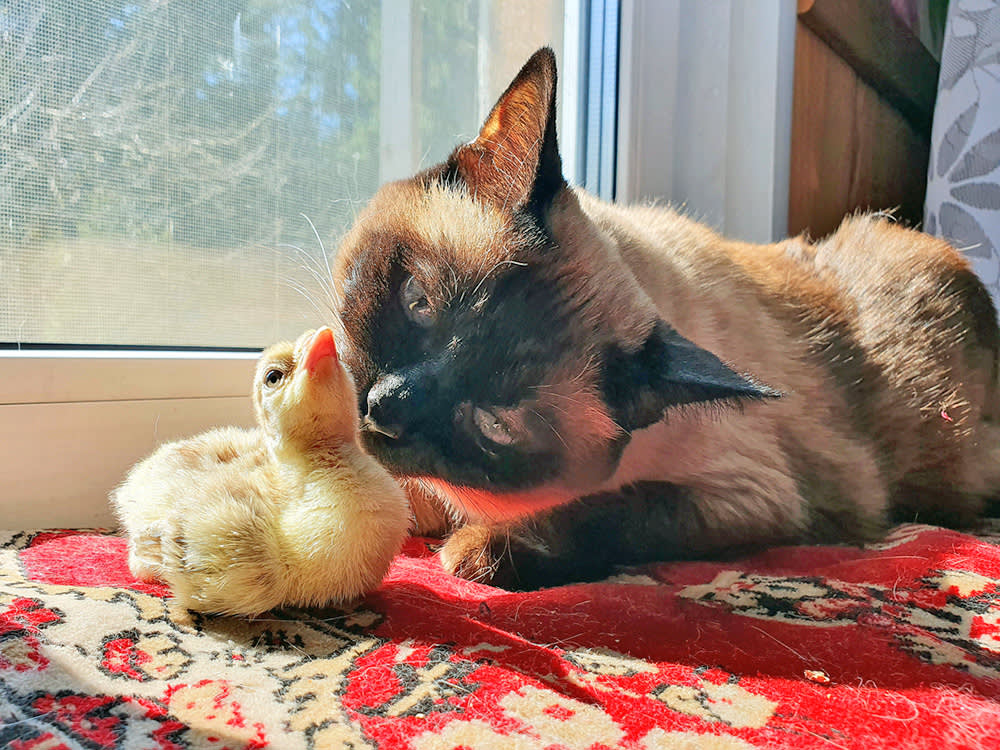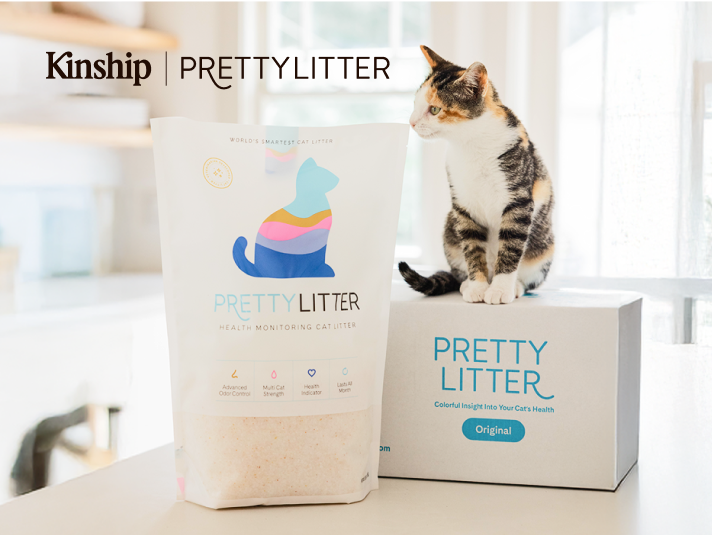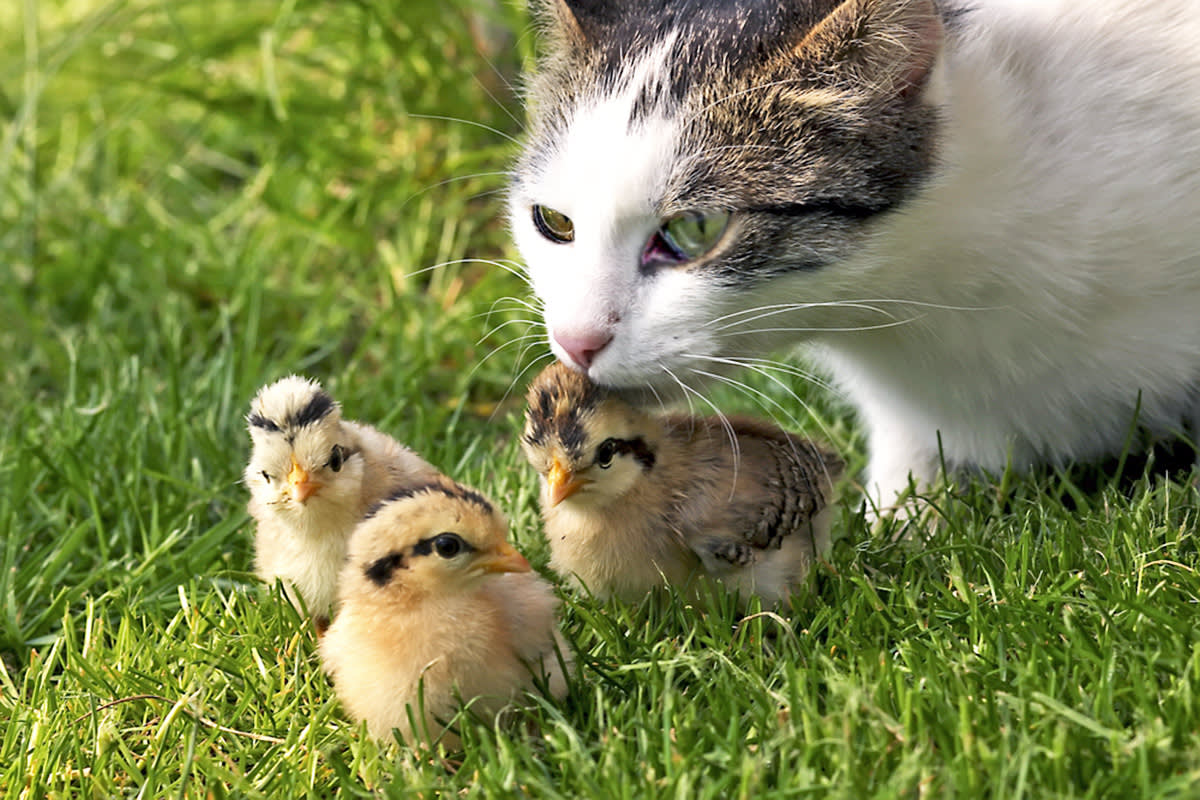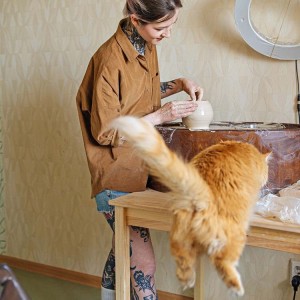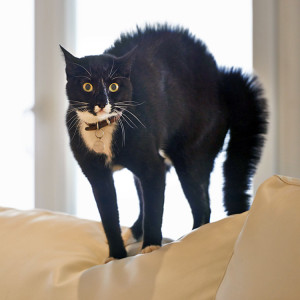Why Do Cats Mother Other Animals? The Truth Behind Interspecies Relationships
It‘s more than just freaking adorable.
Cats have a reputation for being aloof, but time and again they demonstrate just how tender and caring they can be. Any cat parent will tell you: The love of a cat is something truly special. The affection that cats often show one another — playing together, cuddling together, and even grooming one another — is just as sweet.
Cats will often take in orphaned kittens and nurse them as if they were their own. Sometimes, they will even do this for non-cats: puppies, bunnies, and even rats. Do they know the animals they are suckling are so different from them and that they are not their own? Maybe. Probably. But sometimes the desire and instinct to mother overrides everything else.
Save on the litter with color-changing tech that helps you better care for your cat.
Why do cats adopt other animals?
The mothering instinct is so strong in some cats that they don't even seem to care if the babies are actually theirs or not. “At [Animal Care Centers of New Yorkopens in new tab (ACC)] we often put orphaned kittens in with lactating moms, who then begin nursing and providing for them right away,” says certified cat behaviorist Stephen Quandt of Cat Behavior Helpopens in new tab.
“In clinic and rescue settings, I’ve also seen cats ‘adopt’ orphaned puppiesopens in new tab, baby squirrels, and even ducklingsopens in new tab. Grooming, protecting, and even attempting to nurse themopens in new tab,” says Dr. Kathryn Dench, veterinarian and chief scientific advisor at Paw Originsopens in new tab.
How much do you spend on your pet per year?
These cross-species relationships are also hugely popular on social media, going viral with the regularity of a Swiss clock. There is something so beautiful about care that crosses borders of sameness. It feels deeper and truer and more pure. Seeing it in action is inspiring, whether it is a product of will or instinct.
“It’s almost like giving birth causes these mother cats to run a software program of things they need to do,” Quandt adds. “It’s all programmed in. And those instincts are so strong that it overrides any other feelings that might exist.”
So, are cats naturally good mothers?
Although cats are often maligned opens in new tab as being bad mothers — surely you’ve heard the phrase “a cat would make a better mother” used when describing an inattentive human parent — this isn't actually true. If it were, the species would have evolved differently (with kittens ready to hunt and defend themselves from birth) or not at all.
“Most cats are instinctively excellent mothers,” Dr. Dench says. “Good maternal behavior in felines includes grooming, nursing, guarding, and teaching kittens survival behaviors. Even in a domestic setting, where hunting and predation risks opens in new tab are removed, these instincts remain hardwired. Mother cats will often reposition their young, respond to cries, and may even restrict access to their litter to protect them — all classic signs of strong maternal behavior.”
Quandt agrees: “Some reject their young,” he says, “but, in general, most cats are great moms. When their kittens are born they clean them up and begin feeding them and responding to them right away. If a kitten cries, mom is right there.”
Eventually, a mother cat must wean her babies — it takes a lot of energy and calories to feed so many hungry mouths from your own body — but pushing a child out of the den so they can make it on their own is part of good parenting, too. And who knows how the cats themselves feel about it? Maybe they are torn up inside. Maybe they are relieved. Maybe the time to say goodbye comes, and they just do it without a second thought. It’s impossible to know. But what we do know is that while they are raising their babies, there is a connection. Instinct or no instinct, they wouldn’t work so hard to take care of their young if they weren’t attached to them.
Cats can also just have really strong friendships.
It’s also possible for cats to form close bonds with members of other species that have nothing to do with mothering. “My cat Bob Dylan Thomas is completely bonded to my dog Mr. Margaret Atwood,” says poet James Gaynor. “They are both the same shade of gray and every morning I wake up next to this two-headed furball.”
Before Mr. Margaret Atwood, Gaynor had two other dogs: Captain Sully and Emily Dickinson, with whom Bob Dylan Thomas also became deeply bonded. “She liked to groom them and would follow them all over the house,” he says. “When Emily Dickinson [died], Bob Dylan Thomas was heartbroken. I’d come home, and he would be waiting by the front door and then walk around looking for her.”
After a few weeks, Gaynor visited ACC and adopted Mr. Margaret Atwood to help fill the void. It took a few days for him and Bob Dylan Thomas to get used to one another, but now they are inseparable.
Connections like this can also occur between cats and animals that might otherwise be seen as prey. “When I was a child, I had a rabbit who was extremely close with one of our cats,” Dr. Dench says. “They slept side by side, snuggled up together, and shared food — their bowls lined up in a row like equals at the dinner table. Our other cat wasn't quite as affectionate but tolerated the rabbit's presence, and the three of them coexisted peacefully for years. Watching a rabbit and a cat curl up together as companions was a beautiful reminder that emotional bonds don’t always follow species lines.”
There are risks with cross-species relationships, of course.
Of course, just because a cat’s hunting instinct is overridden some of the time doesn’t mean that will always be the case, which is why it is so important to monitor your cat during inter-species interactions. This is especially important if the animal they are interacting with might otherwise be considered prey.
“While true affection can exist between a cat and a prey animal, a cat’s predatory instincts may still be triggered by fast movement, high-pitched squeaks, or vulnerability due to illness,” Dr. Dench says. “I’ve seen rare but heartbreaking cases of cats that peacefully coexisted with small pets for months, only to suddenly attack them during a moment of stress, hunger, or overstimulation.”
And even if your cat forms a bond with a prey animal in your home, that doesn’t mean they won’t attack the same kind of animal outside of your home. It also doesn’t mean that because they bonded with, say, a rabbit that you kept as a pet, they will have the same response to the next bunny you bring home.
You also don’t want to make the mistake of assuming that just because your cat is sweet and gentle with you and every person you bring into your home, they will treat another animal (prey species or not) the same way. “Some cats might be OK or be able to form a relationship with this new animal. But just because a cat is sweet, it doesn’t mean it will treat a mouse as a friend,” Quandt says. “Food is food.”
Introducing your cat to other animals
If you’re hoping to introduce your cat to another cat, Kinship has a great guide here that walks you through the process step by step. Introducing your cat to non-cats can be a bit more complicated, though. Especially when it comes to prey species. “In that case, the best time to do it is probably when your cat is still a very young kitten,” Quandt says, “before they learn the predatory skills that would otherwise put that animal at risk. In that case, it is possible that the bond they form will be able to override their predatory instincts as they grow up.”
If you are still interested in giving it a try with your adult cat, Dr. Dench recommends you start by assessing your cat’s temperament. “Confident, well-socialized, and easygoing cats are more likely to accept other animals,” she says. “If your cat is fearful, territorial, or predatory by nature, introductions must be especially cautious. Always start with scent-swapping before face-to-face meetings. Use baby gates, carriers, or barriers to allow gradual visual introductions. If your cat shows signs of aggression, stalking, or hyper-focus, those are red flags that should not be ignored.”
Whatever you decide to do, just remember that every cat is different and safe interactions and stable relationships across species can be difficult to maintain. Don’t just assume that your cat will get used to whatever animal you try to introduce. That doesn’t always happen, and assuming it will can have dire consequences for both animals. Remember that cats are not the same as humans, and we can never really know exactly what they are thinking or why they do the things they do.
Bask in the love your cat gives you and marvel at their ability to love others. But never forget that they are and will always be a cat, and while the mothering instinct is strong, it may not always be strong enough to override all their others.
